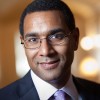Each Monday evening for the first half of this semester, I crossed the backyard of my home, Cromwell Cottage, to Bailey House, to meet the students of my “Biochemistry and Society” seminar. Like many classrooms at Kenyon, our seminar room had an old-school feel, with heavy wood furniture, a fireplace and walls of built-in bookshelves. (We even had a kitchen nearby, where we stored our traditional mid-seminar snack, Pepperidge Farm Pirouette cookies.) The class had, and has, high-tech touches: I co-teach this seminar with my former student (from my days at Mount Holyoke College) Katie Kraschel, a lecturer at Yale Law School and director of the Solomon Center for Health Law and Policy, who attended via Zoom whenever she was unable to be in Gambier.
Though I get to do a variety of things as president, teaching this seminar typically is the high point of my week. Our class discussions are lively, reflecting the provocative nature of some of the topics — questions related to privacy, government regulation, CRISPR therapies, and connections between DNA and racial identity. And while most of the class’s 12 students are majors or minors in the sciences, all have strong interest in interdisciplinary questions and approaches, making for an intellectually exciting environment.
This past Monday, I did not cross my lawn to meet my students in Bailey House. From Cromwell Cottage, I joined a Zoom conference call with my students, who represent every time zone in the continental U.S. To someone like me (of a certain age), the arrangement of the tiles on my monitor was instantly reminiscent of the opening sequence of “The Brady Bunch,” each of us in our own square, the boundaries serving as a reminder of the physical space that separated us (thanks to Assistant Professor of Psychology and her students for sharing the illustrative screenshot above). I am always nervous at the beginning of each class, a reflexive condition that has stuck with me over my 25 years of teaching. But for this class, my first in Kenyon’s temporary period of remote learning, I was especially anxious — how would this actually work, with my students and I scattered across the country?
As expected, the beginning of our remote class had some fits and starts. (By the end of this pandemic, I think all of us will have mastered the skill of efficiently unmuting ourselves on a videoconference.) But the discussion zipped along with its typical momentum and flow. Students asked questions of each other, answered questions, made provocative statements and responded to the provocative statements of others. All of the topics from the first half of the semester came back into play in Monday’s class, which Katie and I had adjusted in order to more directly confront the COVID-19 crisis and its associated bioethical dilemmas. The familiar feel of the seminar room was present (minus the Pirouettes).
How did the class fall into such a natural rhythm while working in a remote format? The answer may be connected to the core of the Kenyon teaching and learning experience, which is rooted in relationships among students and faculty. Our seminar group forged bonds over the course of the first half of the semester, not only through our weekly session but through collaboration on class projects and through regular office hours with me. At this point in the semester, we know each other — our interests, our quirks in conversation — and have developed a sense of trust. That trust frees the conversation, giving moments when it feels like the class forgets the fact that I am president. And that relationship is stronger than distance, stronger than the disruption caused by the pandemic, and will survive this half-semester of remote teaching.
I hear a similar optimism from colleagues across Kenyon’s faculty. For the past two weeks, Kenyon faculty have worked very hard to redesign and restructure their courses (with the support of many staff on campus). That hard work will continue, as students adjust to this new ways of teaching and learning and faculty make continual adjustments and refinements. But, through my conversations with colleagues and now from my own direct observations, I am confident that Kenyon’s tradition of intellectually engaging and exciting teaching and learning will continue through the COVID-19 crisis.
Some have called this crisis-induced experiment that Kenyon and peer liberal arts colleges are embarking upon as a transition to “online” or “remote” education. But in a sense, the education at Kenyon isn’t transitioning to anything — it is staying the same, still grounded in close relationships between faculty and students and among student peers. The current crisis separates us physically, but we’ve built relationships in and outside of the classroom that can and will withstand this. And our learning — having jumped out of Bailey House and into our Brady Bunch tile screen — will continue.
